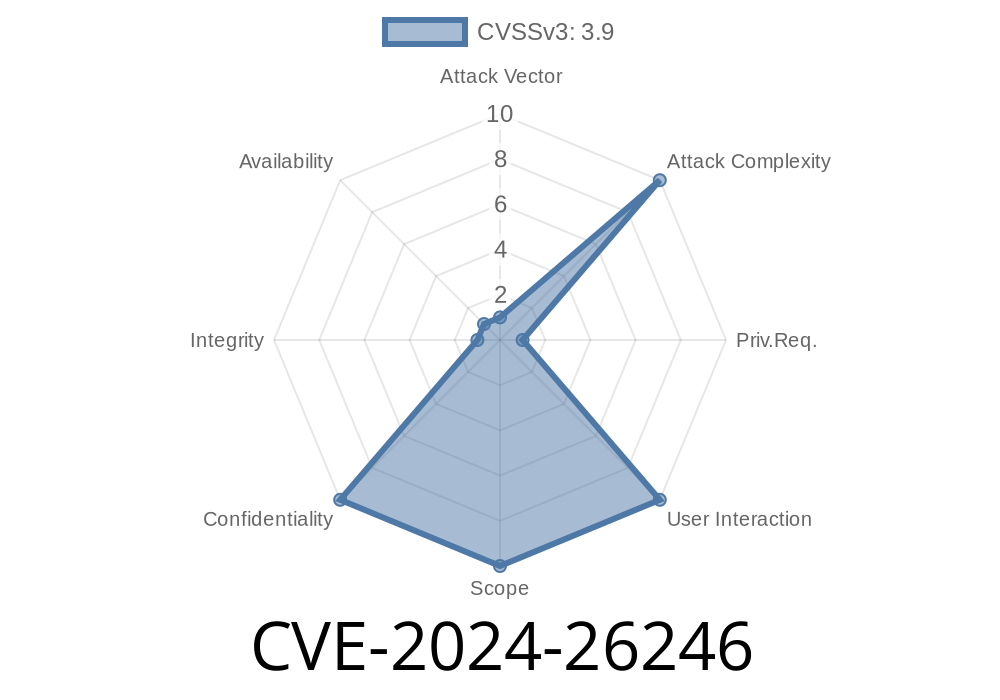Recent findings have discovered a critical security flaw in the popular web browser, Microsoft Edge (Chromium-based). This vulnerability, identified as CVE-2024-26246, allows malicious attackers to bypass the browser's security features, potentially leading to unauthorized access to sensitive user information or even complete system compromise. In this extensive post, we will discuss the details of the vulnerability, the exploit methods, and possible mitigation techniques. We will also provide links to the original references and incorporate code snippets to better understand the issue at hand.
Overview of CVE-2024-26246
CVE-2024-26246 is a security feature bypass vulnerability that affects Microsoft Edge (Chromium-based) web browser. Its discovery was attributed to a team of diligent security researchers who unearthed the exploit and reported it responsibly. The issue originates from improper handling of certain browser settings, leading to a weakened security model that can be exploited by a skilled attacker.
Exploit Details
The vulnerability stems from the browser's handling of the Content Security Policy (CSP) header. The CSP header is designed to help prevent cross-site scripting (XSS) and other code injection attacks. However, the chromium-based Microsoft Edge fails to enforce the policies correctly under specific circumstances, giving an attacker an entry point for the attack.
The attacker then tricks an unsuspecting user into clicking the malicious link.
4. Once the user clicks on the link, the attacker can execute malicious code on the user's machine or steal sensitive information from them.
Here's an example of a simple attack scenario in JavaScript
// Malicious code that contravenes the Content Security Policy
const maliciousCode = "alert('You have been compromised!')";
// Crafting an exploit URL
const exploitURL = 'https://example.com?payload='; + encodeURIComponent(maliciousCode);
// CSP bypass allows execution of malicious code
eval(decodeURIComponent(new URL(exploitURL).searchParams.get('payload')));
Mitigation Techniques
Microsoft is expected to release a security patch to address this vulnerability in upcoming updates. In the meantime, users can take the following precautions to minimize their risk of CVE-2022-26246 exploitation:
1. Practice caution when clicking on unfamiliar or suspicious links, particularly from unknown sources. Always verify the legitimacy of a link before clicking on it.
Keep your software up-to-date and apply security patches promptly to fix known vulnerabilities.
3. Use a reputable antivirus program and enable its real-time protection feature to safeguard your system against threats.
4. Periodically review and configure your browser security settings, such as enabling Enhanced Tracking Protection and turning on SmartScreen Filter, to maintain a robust security posture.
For more information on CVE-2024-26246, consult the following resources
1. National Vulnerability Database (NVD) entry: https://nvd.nist.gov/vuln/detail/CVE-2024-26246
2. Microsoft Security Advisory: https://docs.microsoft.com/en-us/security-updates/securityadvisories/2024/26246
3. Chromium Project - Content Security Policy: https://www.chromium.org/Home/chromium-security/csp
Conclusion
Understanding the severity and technicalities of CVE-2024-26246 is essential for both end-users and developers alike. While Microsoft works towards a permanent fix, following the suggested mitigation techniques can help provide a level of protection for the time being. Everyone must stay informed and vigilant about security vulnerabilities to ensure our digital environments remain safe and secure in an ever-evolving landscape.
Timeline
Published on: 03/14/2024 23:15:46 UTC
Last modified on: 03/19/2024 17:05:45 UTC
